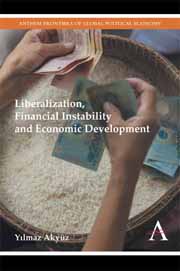Book contents
- Frontmatter
- Dedication
- Contents
- Introduction
- PART ONE LIBERALIZATION, STABILITY AND GROWTH
- PART TWO THE GLOBAL ECONOMIC CRISIS AND DEVELOPING COUNTRIES
- Chapter VI The Current Global Financial Turmoil and Asian Developing Countries
- Chapter VII The Global Economic Crisis and Asian Developing Countries: Impact, Policy Response and Medium-Term Prospects
Chapter VIII - The Staggering Rise of the South?
from PART TWO - THE GLOBAL ECONOMIC CRISIS AND DEVELOPING COUNTRIES
- Frontmatter
- Dedication
- Contents
- Introduction
- PART ONE LIBERALIZATION, STABILITY AND GROWTH
- PART TWO THE GLOBAL ECONOMIC CRISIS AND DEVELOPING COUNTRIES
- Chapter VI The Current Global Financial Turmoil and Asian Developing Countries
- Chapter VII The Global Economic Crisis and Asian Developing Countries: Impact, Policy Response and Medium-Term Prospects
Summary
Introduction and Summary
In the early days of the global economic crisis, growth in developing and emerging economies (DEEs) was widely expected to be decoupled from the difficulties facing advanced economies (AEs). Strong growth that many DEEs had been enjoying since the early years of the millennium was expected to continue with some moderation and prevent AEs and the world economy from falling into recession. In the event, however, growth in DEEs slowed considerably in 2009 as a result of contraction of exports and financial contagion. AEs fell into recession and world income declined for the first time in several decades.
Nevertheless DEEs recovered rapidly, with many emerging economies restoring growth rates close to those enjoyed before the crisis. By contrast, growth in the US has been anaemic and erratic, and deepened debt difficulties and financial fragility in the eurozone have raised the spectre of a second dip. This two-track world economy, the widening growth gap between the South and the North, has resuscitated the decoupling hypothesis that growth dynamics of emerging economies have gained considerable autonomy. While it is generally recognized that it may take several years for AEs to overcome their debt overhang and return to stable and rigorous growth, it is also believed that the rise of the South will generally continue unabated in the coming years and income levels in several DEEs will converge rapidly to those in early industrializers.
- Type
- Chapter
- Information
- Liberalization, Financial Instability and Economic Development , pp. 293 - 327Publisher: Anthem PressPrint publication year: 2014



